How To Clean Out Drip Heads On Drip Line
This Guide will teach you lot everything yous demand to know about Drip Irrigation.
Components Of Drip irrigation organisation
Toll of installation
Regime subsidy
And Guidelines For Maintenance and much other valuable information that I've never shared anywhere else before.
Let's get started…
The available water for agronomics decreases day by day due to the increase in population, industrialization, and short rainfall. It has go essential to employ modern irrigation technologies like Drip irrigation, sprinkler irrigation in agriculture.
Drip irrigation means providing the required quantity of water directly to Ingather plants' root zone through a network of pocket-sized pipes; this is too called micro-irrigation or trickle irrigation.
This is the most efficient irrigation technique.
In the Baste irrigation system, water supplies to plant roots through a collection of plastic pipes, lateral tubes, and valves. These components, controlled with the assist of a dripper and water pump. With the help drip irrigation system, it is easy to provide liquid fertilizer to the plant root arrangement.
Baste Irrigation Advantages
- Baste irrigation Saves water around xxx% – sixty% every bit compared to flood irrigation.
- Information technology is observed that crop yield increase up to 230%.
- Fertilizer use efficiency increase past 30 percent
- Reduce Weed growth
- Save Labour and electricity price is much significantly less than other irrigation methods.
- For baste irrigation, Field leveling isn't vital.
- Piece of cake to maintain Wet almost the root zone
- H2o supply is extremely optional, controlled by manner of each nozzle.
- Help to reduce Soil erosion.
- Enable the utilise of saline water for irrigation
Components Of Drip irrigation system

The drip irrigation system comprises the h2o pump, filter unit, mainline, sub-mainline, lateral pipes, dripper, and other accessories such every bit control valves, pressure gauge, Fertilizer tank/venturi, end cap, etc.
1) Water Pump
A pump of a suitable capacity H2o pump is used to supply water through the drip irrigation system components at a specific level of force per unit area.
If the source of a h2o supply is a bore well, open well, or a Canal, there is the possibility of organic and inorganic foreign bodies in the water. In this case, apply the suction filter to become relatively make clean water.
The electric motors or diesel fuel engines are the common prime mover of the pump. Recently the solar pump is being used to popularize information technology for drip irrigation purposes.
2) Filter unit
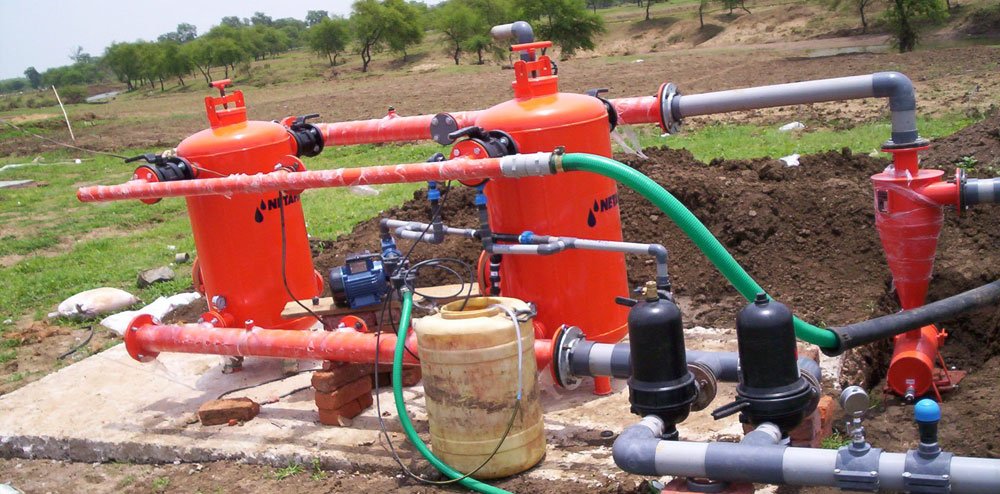
There should be a good quality filter in the control head installation of a drip organisation. The filter uses to make clean the suspended impurities of water supplied by the pump before it reaches to drippers. Impurities in irrigation water may cause blockage of the holes and passage of drippers.
The success of drippers greatly depends on the performance of the filter.
A filter unit cleans irrigation water impurities that are suspended and preclude blockage of holes. There is various type of filter available in the market.
There are Three Types of filters: Hydrocyclone Filter, Media filter, and Screen or Disk filter.
Suitable filters are installed according to the impurities constitute in the source of water.
If the water source is a bore well with less concrete impurities, yous tin can install but a screen filter.
If the water source is an open well or a Canal install screen or disc filter along with sand filter and Hydrocyclone Filter.
To work the baste irrigation system properly 2-stage filter unit is used.
a)Media (Sand/ Garval) Filters
 These filters come equally the chief filter unit, and this is powerful against inorganic suspended solids, biological materials, and other organic substances.
These filters come equally the chief filter unit, and this is powerful against inorganic suspended solids, biological materials, and other organic substances.
Media Filter consists of fine gravel and sand of selected sizes placed in a pressurized tank. It helps to remove organic substances such as algae and other vegetative substances present in the water.
The filters are fabricated up of a circular tank filled with layers of coarse sand and different gravel sizes with a provision of valves or flushing the filter associates in instance of clogging.
The media filters are available in different sizes ranging from 500 to 900 mm diameter with an output of 15 to 50 Cu.M., respectively.
A gravel filter or sand filter is vital for the open reservoir, fifty-fifty where algae growth occurs in the water source.
b) Hydrocyclone Filter
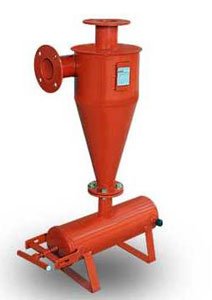
If the irrigation h2o contains more sand particles, hydro-cyclone blazon filters are removed this sand particle by creating centrifugal force and spins out sand from water.
The Hydro-cyclones Filter generates a spinning activity causing the sand particles to dissever the water and be trapped in a storage tank at the bottom of this device.
Hydro-cyclone type filters are produced in various sizes for dissimilar discharge capacities.
c) Screen Filter:
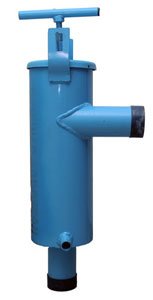
In general, the screen filter consists of a single or double perforated cylinder placed in a plastic or metallic container
for removing the impurities.
More often than not, 100 to 200 mesh screens are used in this type of filter. It must be cleaned and inspected periodically for satisfactory functioning of whatever drip system.
Screen filer is installed with or without a gravel filter, depend upon the quality of irrigation h2o. The screen filter is made upwards of non-corrosive plastic or metal substance.
c) Disc Filter:

Disc filter comes as part of the secondary filter unit. Multiple circular discs filter h2o. it is made upwardly of loftier-quality plastic textile
3) MainLine:
The mainline transfers the total amount of h2o for the irrigation organization. It connects the different sub-mains to a water source. The chief pipes are usually fabricated of flexible materials such as PVC (polyvinyl chloride) or plastics.
The mainline pipe passes water from the filtration unit to the sub-master pipe. This pipe'southward diameter depends upon drips irrigation system menstruum capacity, normally 2.five – 4 Inch diameter PVC piping used as main-line.
Mainline & sub-main should be installed in a Telescopic style; that is, the piping with a larger diameter should be continued first, followed by pipes with a smaller diameter. This system helps to maintain uniform force per unit area in the system.
The Mainline should be buried at least 45 centimeters to prevent them from getting damaged during cultural operation.
4) Submain:
The sub-main feed to the laterals on 1 or both sides. It is made of either medium-density polyethylene (PE) or PVC. There should be a balance betwixt the diameter of the main and sub-mains.
These are determined in consideration of the charge per unit of discharge, number of sub-mains, and friction losses in pipes
5) Laterals:
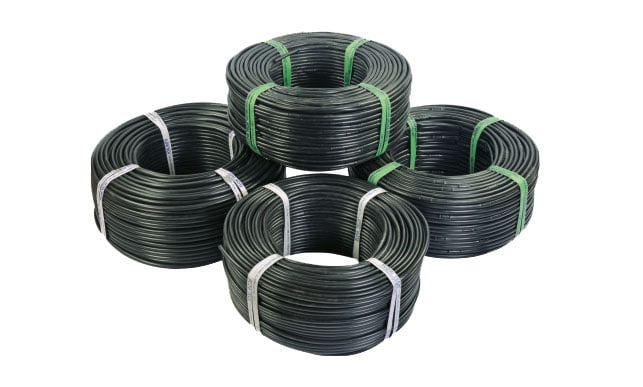 Laterals are made up of low-density polyethylene (LDP) or linear low-density polyethylene (LLDPE) material and are available in different sizes, 12 mm, 16mm, and xx mm.
Laterals are made up of low-density polyethylene (LDP) or linear low-density polyethylene (LLDPE) material and are available in different sizes, 12 mm, 16mm, and xx mm.
Based on the availability of water, crop, and spacing, 12 millimeter sixteen-millimeter laterals install.
6) Drippers:
Drippers are likewise chosen emitters. The dripper is discharging water from the lateral pipe to the soil.
Drippers are more often than not manufactured from polypropylene materials.
Mainly, two types of drippers are available in the market. Online Dripper and Inline Dripper
a) Online Dripper:
 In this type of dripper, they are placed on the lateral, called an online dripper. these drippers are fixed on the lateral by punching suitable size holes in the pipe
In this type of dripper, they are placed on the lateral, called an online dripper. these drippers are fixed on the lateral by punching suitable size holes in the pipe
This type of dripper uses mostly for Orchard Crops like coconut, pomegranate, guava, etc., the capacity to discharge water available is 2L/hour, 4L/60 minutes, and 8L /hour.
b) Inline Dripper:
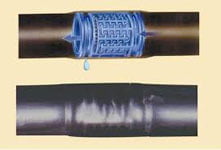 In this type, the dripper is placed inside the lateral piping. The distance between the two drippers is the same. In that location are three types of available inline drippers.
In this type, the dripper is placed inside the lateral piping. The distance between the two drippers is the same. In that location are three types of available inline drippers.
Not-Pressure Compensating Drippers (NPC): This is a very elementary dripper, which does non maintain uniform pressure
Pressure level Compensating Drippers (PC): This dripper is more avant-garde; it maintains compatible pressure in all drippers. It mostly uses for the greenhouse crop, the toll of this dripper is slightly high.
Not-Draining Drippers: This dripper is mainly used in a soilless-like mediums likecocopits,Perlite, and Vermiculite.
7) Fertilizing Unit
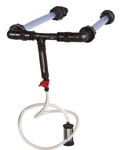
The direct application of fertilizer through drip irrigation has increased the efficient use of fertilizer and saving in labour and money.
With this fertilizing unit's assist, liquid fertilizer is provided to the plant through a baste irrigation organization.
Application of fertilizer into irrigation system is fabricated by either a by-pass pressure tank or by venture pump or directly
injection organization.
8)Force per unit area Approximate:
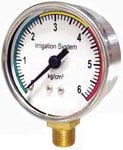
It is used to determine h2o pressure in the baste irrigation system.
8) Controls Valves
 This value is used to control water flow. They made up of plastic and atomic number 26 material
This value is used to control water flow. They made up of plastic and atomic number 26 material
9) Flush Valve:
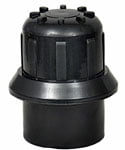 The flush valve is placed at the end of the sub-Maine pipe it uses to flush out dirt.
The flush valve is placed at the end of the sub-Maine pipe it uses to flush out dirt.
ten) Not-Return Valve
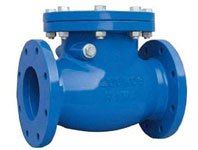
Non -return valve is useful to stop render h2o toward the water pump.
11) Air valve
 It helps prevent the sucking of mud past the drippers and release air into the drip irrigation system.
It helps prevent the sucking of mud past the drippers and release air into the drip irrigation system.
12) Endcap
The end cap is used to close one cease of the lateral pipe; they remove information technology at the cleaning time.
Types of Drip Irrigation System
Their many types are available in drip irrigation here. Only ii popular types are explained.
1) Surface drip system
In the surface baste system, the emitter and lateral piping are placed on the soil surface. This is the most mutual and popular blazon of baste system.
It is suitable for wide-spaced plants as well as for row crops. It is easy to employ a surface baste to observe and audit, change, clean the emitters, observe surface moisture patterns, and measure individual emitter belch rates.
2) Sub-surface baste system
in a subsurface drip irrigation system, the lateral is placed below the ground and near the constitute root zone surface area. In this organization, h2o is slowly applied below the surface through the emitters.
Sub-surface drip systems accept gained wider acceptance due to removing earlier bug of clogging to a large extent.
Due to the sub-surface drip method, there is less intervention in agronomics or any cultural practices and possibly more operational life.
Sub-surface baste system provides picayune interference with tillage or whatever cultural practices and possibly longer operational life.
Drip Irrigation System suitable for this crop
| Ingather Type | Crop |
|---|---|
| Vegetables | Tomato, Capsicum, Cabbage, Chilly, Cauliflower, Onion, Brinjal, Bitter Gourd, Ridge Gourd, Peas, Cucumber, Pumpkin, Spinach etc |
| Greenbacks Crops | Sugarcane, Tobacco, Cotton |
| Poyhouse crop | Gerbera, Dutch rose, Carnation, Anthurium, Lily, Orchids, Strawberry, etc |
| Plantation Crop | Java, Kokosnoot, Tea, Rubber, etc |
| Orchard Crops | Banana, Grapes, Citrus, Orange, Pomegranate, Mango, Guava, Pineapple, Cashewnut, Coconut, Papaya, Watermelon, Muskmelon, Litchi, Lemon, etc |
Drip Irrigation Arrangement Price
The Cost of drip irrigation system installation depends upon diverse factors, like what kind of crop you are sowing, type of terrain, quality of soil, sowing pattern, water quality, quality of baste material, industry company of baste irrigation system, and design of the baste irrigation system.
Baste irrigation system cost per acre For vegetable crop will come up effectually Rs. 50,000–65,000 per acre approximately and For fruits crop, if planted in the 3X3 pattern price per acre for drip irrigation system come up around 35,000- 40,000 approximately.
Government Suggestive toll of drip irrigation system:

Ref: Pradhan Mantri Krishi Sinchayee Yojana (PMKSY)
Suppose you are using not-ISI textile; your initial cost for one acre comes around 20,000-25,000 rupee for the vegetable crop, just the life of non-ISI material for 2-3 years with loftier maintenance toll. At the aforementioned fourth dimension, the life of ISI fabric is vii-ten years with low maintenance.
Government subsidy for baste irrigation
The subsidy is available for Baste irrigation in Republic of india under Pradhan Mantri Krishi Sinchayee Yojana (PMKSY). The government of Bharat gives subsidies per beneficiary upward to five hectares. At that place has been financial assistance under different categories and depending upon States' categories for dessert, drought, hilly, and other regions of the country. For more detail, check the PMKSY website or contact the nearest agriculture office.
List of Top Drip irrigation companies
These are the Top Drip irrigation manufacturer company in Bharat.
- Netafim Irrigation
- Jain irrigation system
- Finolex Plasson Industries
Guidelines For Maintenance Of Drip irrigation system
Drip irrigation is a mechanical system, which performs at a specific force per unit area of water; if the arrangement has to perform well for a long time, the pressure should be properly maintained.
Even if skilful quality materials are used and installed scientifically, there is a possibility of failure. If the field maintenance is not proper and regular, therefore, the drip irrigation system'due south management is very important.
Follow these guidelines to maintain drip irrigation system –
A. General care
- Cheque all Working emitters or Dripper, Inspect the water leakage, and make sure that water is uniformly distributing all of the corners of this plot/field.
- Check the water dispensation surface area. If their dry patches are establish, increase drip irrigation operation fourth dimension.
- If a twist, fold, cut, puncher is observed on the lateral, sub-main, valve correct it immediately.
B. Clean the filters.
The filter is the main function of the drip irrigation ready. If the filter is not working properly, there is a major gamble of complete baste irrigation system Failure.
1. Sand filter:
Clean sand filter after every calendar week. The backwashing facility available in the sand filter uses this by allowing h2o to flow through the lid instead of the water valve and stir the sand in the filter. So, the waste which is sitting at the bottom will come and go out of the h2o
2. Screen Filters/ die filter:
Open up the lid and remove the mud and garbage trapped. Open up the filter and remove the filings and safety seals and make clean information technology on both sides.
3. Submain pipe and Laterals tubes:
Sometimes a fine particle, dirt passes through the filter and shop in the main and sub-main tubs, Laterals; therefore, to clear these tubes, remove the terminate cap, Flush Valve and let the water flow. Do this until the clean water come.
C. Chemical Handling:
The drippers are stopping working due to various alkali
If the amount of carbonate, bicarbonate, chlorides, sulfur, manganese, and calcium, sulfur sulfate is higher in water, yellowish dots appear, and the ruby dots appear dripper, and if the corporeality of iron is loftier red spot appear on the dripper following treatment carried out.
1. Acid Handling:
Acid treatment is useful for though dripper and laterals blocked by various chemical impurities, including fertilizer residue. This impurity can be removed by treating the system either with hydrochloric acid or sulphuric acid or nitric acid. This hydrochloric acid at 25% is best for acid treatment.
Method:
Take the required corporeality of hydrochloric acid in h2o. Inject it into the system through the Venturi or fertigation tank. The system is filled with water allows acid solution into the system until the pH of 4. A cheque pH with litmus paper for both at the starting and the terminal dripper. Shut the arrangement for 24 hours.
The acidified h2o in the system reacts with the salts deposited in the system and dissolves it. After 24 hours, they acidify water along with the dissolved solids coming out of the organisation by flashing.
ii. Chlorine reaction:
Chlorination is useful to remove the biological impurities collected in the drip irrigation organisation. Chlorination can exist washed either using calcium hypochlorite, sodium hypochlorite, chlorine or calcium hydrochloride, or bleaching powder.
Method
Deliquesce the required quantity of bleaching pulverization in water one day before handling. This solution is let into the system through Venturi or fertigation tank and allows it to stay in the system for 24 hours. after that, open the finish caps of the lateral and run the organization for about an 60 minutes and then that the impurities are thrown out of the system
Drip Irrigation Disadvantages/ Limitation
Despite observed successes, some problems take been encountered in applying h2o with drip equipment for some soils, water qualities, and ecology conditions. Some important limitations are described beneath:
1) Persistent Maintenance Requirements
Dripper clogging is considered the most serious problem in Drip irrigation unless preventive measures are taken. Information technology is, therefore, necessary that water should be filtered properly.
Too this, salts and chemical deposits can be deposited in an emitter or lateral pipage. This leads to Bottleneck. It will adversely affect the rate and uniformity of water application, increment maintenance costs, and result in ingather impairment and decreased yield if not detected early and corrected timely.
Other maintenance issues include pipeline leaks and cracking of the tubes. Rodents, coyotes, rabbits, and dogs can chew and damage dripline, and ants and other insects occasionally take enlarged openings in baste tubings.
2) Economic – Initial cost
As the equipment requirements are numerous with drip irrigation, initial investment and annual costs may be loftier compared to surface or portable sprinkler irrigation systems.
The bodily prices of drip irrigation system equipment will vary greatly depending on the types of crops, grades of pipelines, filtration equipment, and fertilization equipment, etc.,
3) Salinity Hazards
If the drip system is used under saline atmospheric condition, it should exist taken actress care to manage drip irrigation work properly.
4) Technical knowledge
High skill is required for drip irrigation organization design, installation, and subsequent functioning.
Technical improvements in the designs of emitters, fittings, filters, etc., have been necessary;
The evolution procedures for preventing or correcting emitter bottleneck and equipment failure accept been difficult, and the development of the proper methods for injection of fertilizers and other chemicals has sometimes been a
Problem.
A higher level of design management and maintenance is required with drip than other irrigation methods.
Image source :
- www.indiamart.com
- www.wikipedia.org
Source: https://agricultureguruji.com/drip-irrigation/
Posted by: browntoosed.blogspot.com


0 Response to "How To Clean Out Drip Heads On Drip Line"
Post a Comment